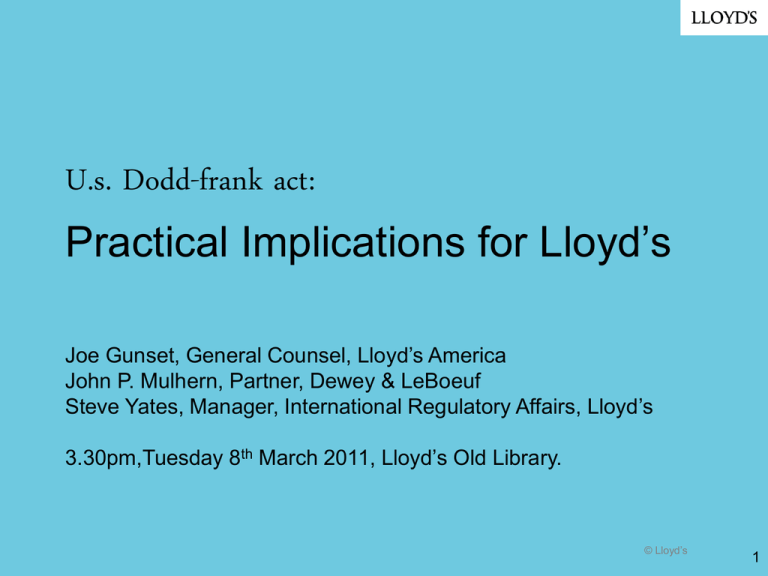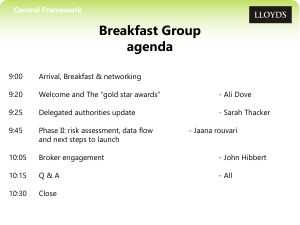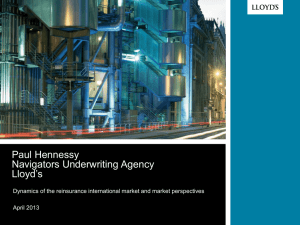Ethical Trading
advertisement

U.s. Dodd-frank act: Practical Implications for Lloyd’s Joe Gunset, General Counsel, Lloyd’s America John P. Mulhern, Partner, Dewey & LeBoeuf Steve Yates, Manager, International Regulatory Affairs, Lloyd’s 3.30pm,Tuesday 8th March 2011, Lloyd’s Old Library. © Lloyd’s 1 Agenda Introduction Sean McGovern Reinsurance Business Joe Gunset Surplus Lines Business John Mulhern Next Steps/Communications Steve Yates Questions © Lloyd’s 2 History – A LONG JOURNEY....... • In the 1990’s post Lloyd’s R&R: U.S. Trust Funds established. 3 years lobbying to secure competitive terms for Surplus Lines Trust Funds Focus on initiating and subsequently progressing international lobbying effort on funding issues • Focus during last decade on: NAIC and model law reform Key states business case rationale for reform Need for harmonised implementation of reform at Federal level. International dimension, instigated U.S./E.U. dialogue © Lloyd’s 3 THE PRESENT – WHERE HAVE WE REACHED? • Post financial crisis: U.S. changing regulatory dynamic. Has triggered a raft of legislation. Lloyd’s well positioned to leverage opportunities for change • Dodd-Frank includes key reforms: Created Federal Insurance Office. Prospect of International Agreements. Nonadmitted and Reinsurance Reform Act (“NRRA”) © Lloyd’s 4 Overview of dodd-frank act insurance provisions • Created Federal Insurance Office (“FIO”) FIO has no direct regulatory authority, but is tasked with monitoring the insurance industry and assisting in the negotiation of international agreements • International Agreements Secretary of Treasury and U.S. Trade Representative authorized to enter into international agreements on prudential regulation • Nonadmitted and Reinsurance Reform Act (“NRRA”) Creates federal mandates regarding how states may regulate reinsurance and surplus lines transactions Effective 21 July 2011 © Lloyd’s 5 Implications: reinsurance business © Lloyd’s 6 Potential for Federal Level Solution • Process for Federal Level Collateral Rule Treasury and US Trade Representative have authority to negotiate international agreements on prudential matters Once an agreement is in place, FIO Director has authority to examine and, if appropriate, pre-empt state laws that are inconsistent with such agreement • Lloyd’s Position Lloyd’s is liaising with Treasury and US Trade Representative and plans to lobby for an agreement on reinsurance collateral We see a federal solution as the best option for nationwide collateral reduction However, we do not expect this process to happen quickly - It will likely be several months before any significant progress is seen There are a number of obstacles - FIO Director has not yet been appointed © Lloyd’s 7 NAIC and State Based Initiatives • NAIC NAIC Reinsurance Task Force has exposed for comment draft revisions to the model Credit for Reinsurance law and regulation that would allow for reduced collateral The comment period ends 23 March and this issue will be discussed at the NAIC annual meeting at end of March • Florida and New York Currently have reduced collateral rules in place • Other states are working to put in place rules similar to those enacted by Florida and New York New Jersey bill recently passed legislature and will become law if signed by Governor Indiana legislation likely to pass this year © Lloyd’s 8 Florida and New York • Since a nationwide collateral reduction rule is not yet in place in the US, Lloyd’s is taking advantage of the state based rules that are in place Lloyd’s has filed applications with Florida and New York to be recognized as an eligible reinsurer under these rules This will allow underwriters to take advantage of reduced collateral on a single cedant basis by providing a letter of credit for a particular cedant in lieu of posting collateral in the CRTF Cedants receiving LOCs under the reduced collateral rules will not be covered by the CRTFs or JATFs, to avoid duplication of security Lloyd’s does not intend to set up a separate MBRT for reduced collateral cedants at this time It is important to note that Florida has advised that approval for reduced collateral is currently being limited to property catastrophe business © Lloyd’s 9 Summary: Impact on Lloyd’s Reinsurance Business • Pushing for International Agreement Lloyd’s is lobbying for an international agreement that would create nationwide reduced collateral • Getting Approved Under Current State Rules Lloyd’s has applied to be recognized under Florida and New York’s rules and expects to be approved soon • Monitoring NAIC and Other State Initiatives Lloyd’s will continue to engage with NAIC Reinsurance Task Force and state regulators to encourage additional collateral reduction rules © Lloyd’s 10 Implications: Surplus Lines business © Lloyd’s 11 Surplus lines: eligibility • Filings responsibility of both managing agents & Lloyd’s: Syndicates make individual state eligibility returns in May each year. Lloyd’s produces in excess of 180 U.S. returns including: – Eligibility returns state by state – Supported by transactional data at state level – Annual filing with the NAIC IID – Quarterly and annual Trust Fund solvency filings Returns include a mixture of financial, statistical & global financial details Trend towards increased data demands and more intrusive review © Lloyd’s 12 Surplus lines: eligibility • Under NRRA states cannot prevent brokers from placing surplus lines business with insurers listed on IID White List • Role of the IID office will therefore be more significant for alien surplus lines insurers that are listed on the White List Lloyd’s is liaising with IID concerning potential changes to the normal 15 May Lloyd’s syndicate filings © Lloyd’s 13 State eligibility requirements • Important to note that individual states may continue to request data. State regulators ultimately determine IID policy and may want separate data which may be deemed relevant to in-state activity There is a wide variety of state NRRA legislation currently pending – no two bills are precisely alike – State legislation needs to be changed to reflect NRRA but there is a lack of consistency and many statutes appear to conflict with NRRA. Examples include: – Creation of a two-tiered system whereby insurers that continue making state eligibility filing would be “preferred” – Repealing MAT exemptions – States are also proposing increases in fees and penalties © Lloyd’s 14 Premium Taxes and Compliance for Placements • Only the home state can tax and regulate a multistate surplus lines transaction. • Home State Principal Place of Business or Individual’s Residence; or If 100% of risk located outside state described above, state where greatest percentage of premium is allocable. • But the NRRA provides that the states can create an agreement to allocate tax collected on multistate surplus lines risks. © Lloyd’s 15 Tax Allocation Proposals • Competing proposals NIMA – NAIC drafted NIMA which addresses only tax allocation – This is opposed by industry but several states appear to be leaning towards adoption SLIMPACT – More comprehensive than NIMA – Supported by NAPSLO but fewer states seem to be following this approach Other – Some states have introduced legislation that simply changes state law to bring it into compliance with NRRA, however, many of these state bills appear to have inconsistencies © Lloyd’s 16 How Tax Allocation Affects Lloyd’s • Not just a SL intermediary/coverholder/broker/XIS problem! Data Collection – Currently, brokers required to report premium tax allocation by state. Brokers will also be required to begin reporting home state – Depending on which allocation system, if any, is adopted by the states Lloyd’s may need to change data collection procedures – At this point, Lloyd’s does not intend to change or reduce data collection requirements since it seems likely that some allocation will be required for multistate surplus lines risks – NAPSLO published their intent to provide regulators / carriers with home state only, allocating premium where the home state requires. – Deciding next steps will require careful consideration taking into account many factors. © Lloyd’s 17 How Tax Allocation Affects Lloyd’s • Premium Statistical Reports Lloyd’s currently files premium statistical information annually with U.S. states Not clear whether these requirements will change after NRRA becomes effective Since states use this information to reconcile broker filings and ensure they get the full amount of premium tax, it’s likely these will continue to be required in some form © Lloyd’s 18 Effect on Lloyd’s Licensed Business • Lloyd’s is an admitted (licensed) insurer in Kentucky and Illinois • Multistate Risks Multistate risk surplus lines placements sometimes include risks located in Kentucky or Illinois For these risks the portion of the premium allocated to Kentucky or Illinois may be carved out and premium tax paid on an admitted basis for that portion of the premium • Admitted Business Will Continue to be Carved Out Brokers will need to continue reporting Kentucky and Illinois admitted business and allocating premium so that Lloyd’s can pay the appropriate licensed tax © Lloyd’s 19 Potential Implications for master policies/Group Insurance • Treatment of Group Insurance Under NRRA Our view is that the home state for a group insurance policy under the NRRA definition is the state where the master policy is issued, though as under current rules, not all states may agree with this view • This issue will be addressed in detail as part of a separate presentation © Lloyd’s 20 Regulatory & political Backdrop • State Legislation States are rushing to change their laws and incorporate the mandates of NRRA, but much of this legislation is problematic • Political Pressures Extreme budgetary pressures mean states need as much tax premium as they can get – Competing models for tax allocation – Some states may simply keep 100% of the tax Changes in Insurance Commissioners and Staff – New regulators may not have the background on Lloyd’s issues – Lloyd’s is working to educate regulators and explain the market's business model © Lloyd’s 21 Summary: Impact on Lloyd’s Surplus Lines Business • Maintain Eligibility For now, Lloyd’s is continuing to make annual eligibility filings with the IID and, through 2011, individual states Going forward, Lloyd’s hopes to be able to reduce required filings since we are listed on the IID white list • Continue Data Collection on Allocation of Premium Tax Lloyd’s will continue to collect data on allocation of premium taxes for multistate risks and will make premium statistical filings Lloyd’s will continue to allocate premium for admitted business in Illinois and Kentucky, as may be required, and pay the admitted premium tax © Lloyd’s 22 Summary: Impact on Lloyd’s Surplus Lines Business • Engage with NAIC and State Regulators Lloyd’s is liaising with the IID and state regulators to ensure that any changes in filing requirements take into account Lloyd’s unique structure • Requires that Lloyd’s gives greater emphasis to its relationship with the NAIC IID office and supervising regulators • Lloyd’s will continue to monitor and review position regarding Master/Group policy business & consult with market where necessary © Lloyd’s 23 Next steps • Lloyd’s will: Continue to engage with U.S. regulators at state and federal level to ensure Surplus Lines eligibility and compliance burden on Lloyd’s market is kept to a minimum. Drive forward relief at state level on reinsurance collateral reform Seek Federal solution for nationwide collateral reduction Continue to monitor and review position regarding Master/Group policy business Review impact upon Kentucky & Illinois admitted business and consult with market where necessary. © Lloyd’s 24 Regulatory Communications • • • Continued engagement with key sector groups in London & U.S. Targeted communications advising progress Repository of useful information accessed via dedicated page under “Key Projects” on “Lloyds.com Regulatory communications” page. This includes: Title V of the Dodd-Frank Act and summary of key provisions Regulatory updates addressing Dodd-Frank Letter to managing agents, dated 14 February, 2011 detailing Lloyd’s response Detailed timeline of key events and planned communications • Next planned communications: Q1 Mar Market communication – Update on Lloyd’s state level collateral applications Q2 Apr Market bulletin – detailed guidance on practical implementation of state level collateral arrangements Q2 May Market bulletin – setting out approach to data collection after 21 July 2011, NRRA effective date © Lloyd’s 25 questions © Lloyd’s 26 Disclaimer This document is intended for general information purposes only. Whilst all care has been taken to ensure the accuracy of the information, Lloyd’s does not accept any responsibility for any errors and omissions. Lloyd’s does not accept any responsibility or liability for any loss to any person acting or refraining from action as the result of, but not limited to, any © Lloyd’s statement, fact, figure, expression of opinion or belief in this document. 27









